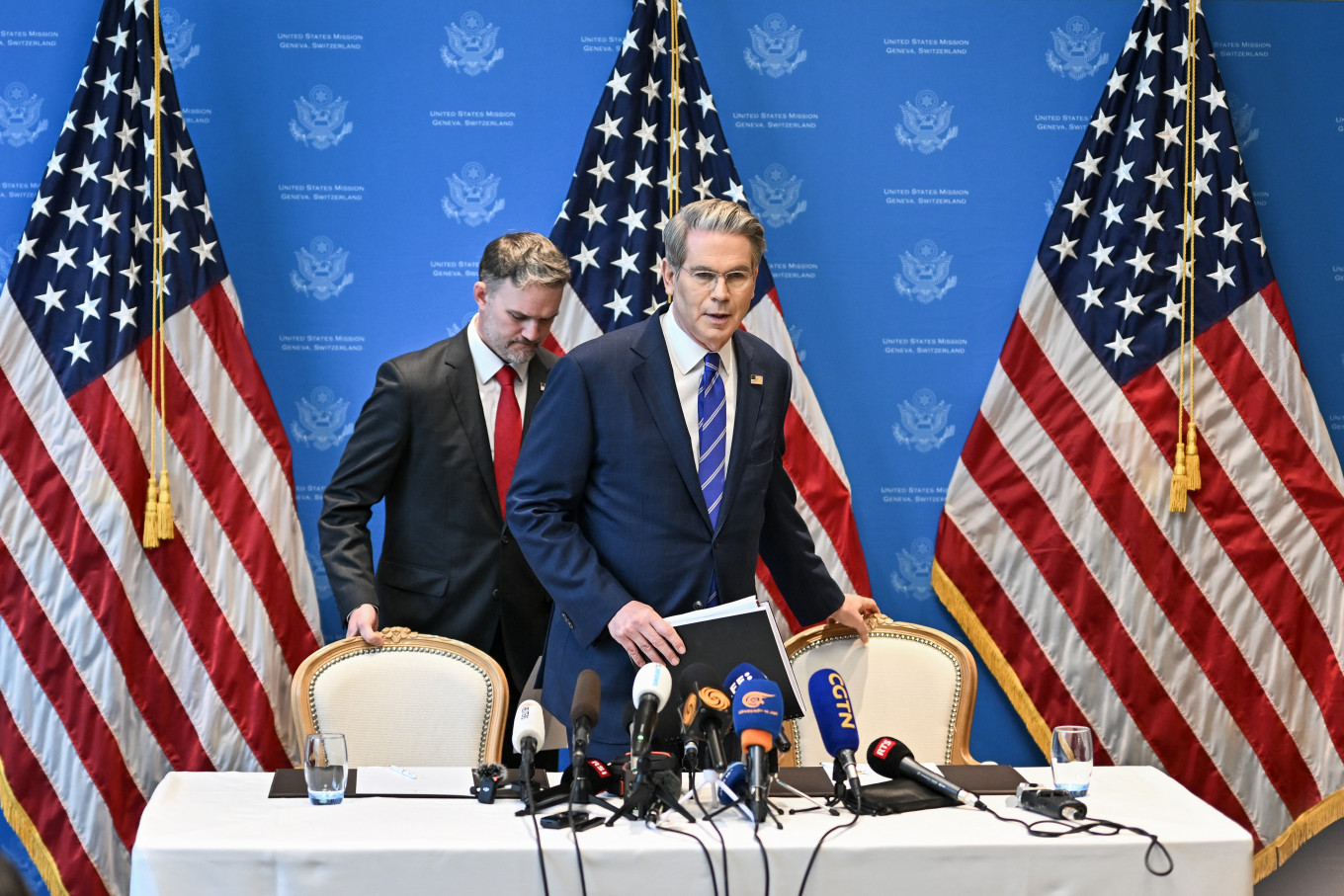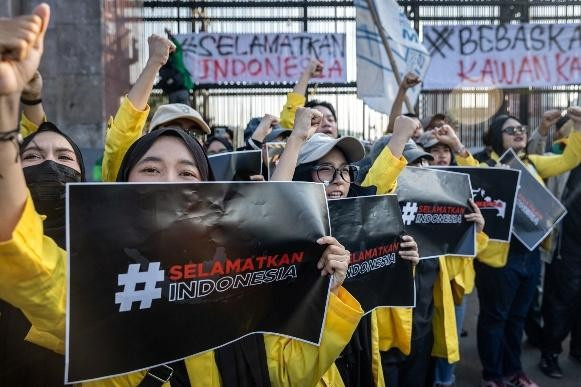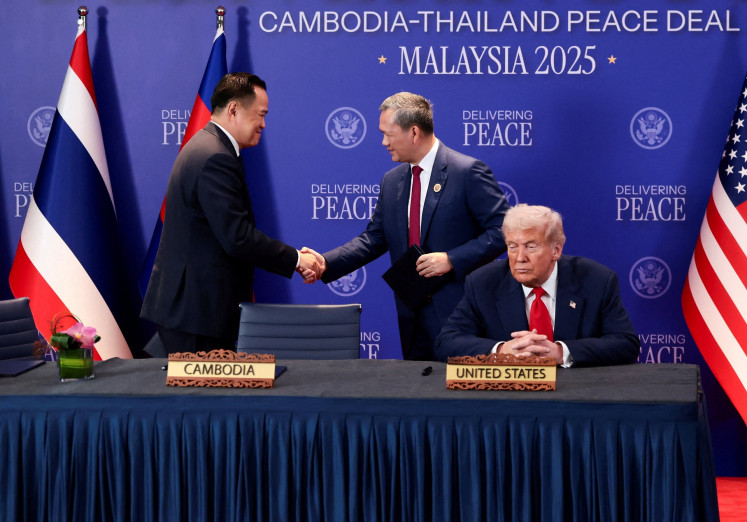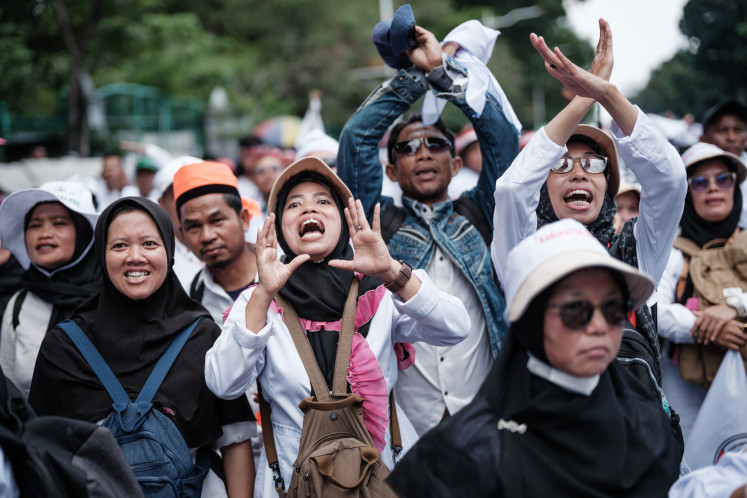Popular Reads
Top Results
Can't find what you're looking for?
View all search resultsPopular Reads
Top Results
Can't find what you're looking for?
View all search resultsUS-China trade deal is no cause for celebration
The Geneva tariff deal may offer short-term relief, but it should not be misread as tariffs remain high and strategic rivalry continues.
Change text size
Gift Premium Articles
to Anyone
 US Treasury Secretary Scott Bessent (right) and US Trade Representative Jamieson Greer arrive to deliver a news conference in Geneva on May 12, providing details of “substantial progress“ following a two-day closed-door meeting between US and China which, according to top officials, was aimed at ending a devastating tariff war. (AFP/Fabrice Coffrini)
US Treasury Secretary Scott Bessent (right) and US Trade Representative Jamieson Greer arrive to deliver a news conference in Geneva on May 12, providing details of “substantial progress“ following a two-day closed-door meeting between US and China which, according to top officials, was aimed at ending a devastating tariff war. (AFP/Fabrice Coffrini)
I
n a much-hyped breakthrough in Geneva over the weekend, the United States and China agreed to temporarily reduce tariffs on each other’s goods.
The US will lower its tariffs on Chinese imports from 145 percent to 30 percent, while China will scale back its own 125 percent duties on US products to 10 percent.
Markets welcomed the news. Commentators spoke of deescalation. But a deeper analysis reveals this is less a truce and more a tactical timeout, meant to avert a broader financial crisis, not reset global trade.
This so-called breakthrough masks enduring strategic distrust. Washington’s high tariffs reflect a persistent desire to pressure Beijing without inviting outright retaliation. And China’s tariff reduction, though steep, is a pragmatic concession: Beijing needs key US imports to stabilize inflation and revive growth.
Yet beneath this surface lies a shared concern neither side wants to voice directly, the US bond market.
Beijing remains one of the largest foreign holders of US Treasury securities. Over recent months, it has reduced reinvestment in these bonds, letting them mature without replenishment. While China has not executed a “dump” of treasuries, even the perception of such a move is enough to unsettle US markets.
In this light, the tariff cut serves a different purpose. It is an insurance policy for the US Treasury market. Washington, facing rising deficits, cannot afford weakened investor confidence. This gesture to China is meant to signal stability, not generosity.
The Geneva announcement does little to change the structural tensions between the world’s two largest economies. Tariff levels remain historically high.
The Biden administration (2021-2025), despite criticizing his successor Donald Trump’s 20 percent tariffs on China during its early days, ultimately upheld most of them, illustrating bipartisan convergence on economic containment of China.
This is not normalization, it is the normalization of confrontation.
While some trade restrictions are temporarily lifted, others, such as technology export controls and investment barriers, remain firmly in place. The real competition is not about tariffs but about dominance in strategic sectors like semiconductors, artificial intelligence (AI), rare earths and quantum computing.
This agreement merely postpones a broader strategic decoupling that has been underway since the US-China trade war began in 2018.
America’s economic approach now hinges on selective engagement, where cooperation exists in low-risk sectors, but critical technologies and infrastructures are fenced off.
Beijing, in turn, continues its own “dual circulation” strategy to insulate itself from Western economic shocks. China wants to trade, but not on Western terms. And the US wants trade, but without dependence.
So, what does it mean for ASEAN?
Southeast Asia, as always, must read between the lines. ASEAN thrives on free trade, having eliminated tariffs on 99 percent of goods traded within the bloc. It has no appetite for superpower standoffs. Yet the region often suffers collateral damage.
From rerouted supply chains to capital flight, every twist in US-China trade relations ripples through ASEAN economies. Countries like Vietnam and Indonesia may benefit from some trade diversion, but they also face long-term instability when global norms are constantly upended.
As ASEAN chair in 2025, Malaysian Prime Minister Anwar Ibrahim has rightly emphasized the need for multilateral trade platforms like the Regional Comprehensive Economic Partnership (RCEP), dubbed the world’s largest trade pact, to buffer against great-power volatility.
ASEAN cannot afford to be reactive, it must help shape the rules of regional trade through active leadership.
Both Washington and Beijing overestimate their leverage. The US believes its control over high-tech exports gives it the upper hand. China believes its role in global supply chains and US debt holdings grants it immunity. But both sides are wrong.
Leverage without trust is volatility. And when two economic giants weaponize trade and finance, the entire global system is placed under strain.
The Geneva tariff deal may offer short-term relief, but it should not be misread. Tariffs remain high. The strategic rivalry continues. And the danger of economic nationalism is ever-present.
For Indonesia and ASEAN, the message is clear, we must double down on regional trade integration, support rules-based multilateralism and avoid dependence on either pole. This is not peace, it is merely the postponement of pressure.
***
The writer is a professor of ASEAN studies at International Islamic University Malaysia.










